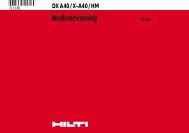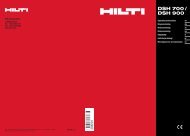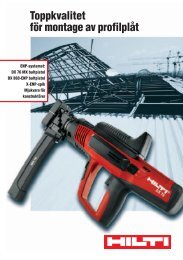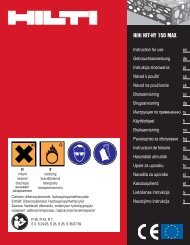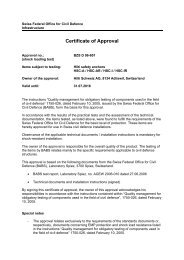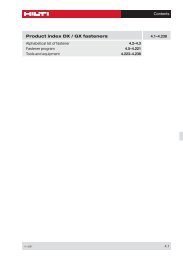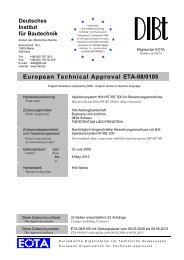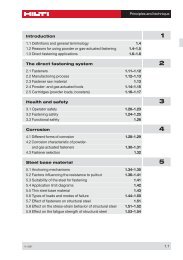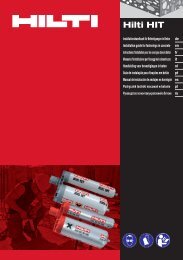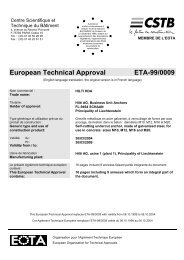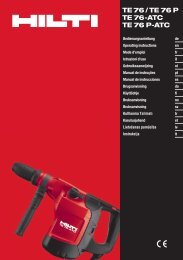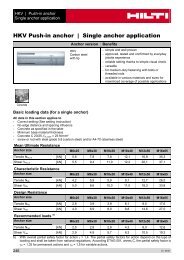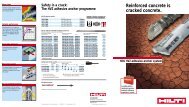European Technical Approval ETA-99/0009
European Technical Approval ETA-99/0009
European Technical Approval ETA-99/0009
You also want an ePaper? Increase the reach of your titles
YUMPU automatically turns print PDFs into web optimized ePapers that Google loves.
Page 3 of <strong>European</strong> <strong>Technical</strong> <strong>Approval</strong> <strong>ETA</strong>-<strong>99</strong>/<strong>0009</strong><br />
II SPECIFIC CONDITIONS OF THE EUROPEAN TECHNICAL APPROVAL<br />
1 Definition of product and intended use<br />
1.1. Definition of product<br />
The HILTI HDA anchor in the range of M10 to M20 is a self-cutting undercut anchor made of<br />
galvanised steel. The HILTI HDA-R anchor in the range of M10 to M16 is a self-cutting undercut<br />
anchor made of stainless steel. Both are available as pre-setting (HDA-P and HDA-PR version)<br />
and as through-fastening anchor (HDA-T and HDA-TR version). They are placed into a hole<br />
drilled with a special stop drill bit and self-cutting undercut using a special setting tool. The nut is<br />
torque tightened to complete the fastening of the fixture.<br />
For the installed anchor see Figures given in Annexes 1 and 2.<br />
1.2. Intended use<br />
The anchor is intended to be used for anchorages for which requirements for mechanical<br />
resistance and stability and safety in use in the sense of the Essential Requirements 1 and 4 of<br />
Council Directive 89/106/EEC shall be fulfilled and failure of anchorages made with these<br />
products would compromise the stability of the works, cause risk to human life and/or lead to<br />
considerable economic consequences. The anchor is to be used only for anchorages subject to<br />
static or quasi-static loading in reinforced or unreinforced normal weight concrete of strength<br />
classes C 20/25 minimum to C50/60 maximum according to ENV 206-1: 2000-12. It may be<br />
anchored in cracked and non-cracked concrete.<br />
The HDA-P and HDA-T anchors may only be used in concrete subject to dry internal conditions.<br />
The HDA-PR and HDA-TR anchors may be used in concrete subject to dry internal conditions<br />
and also in concrete subject to external atmospheric exposure (including industrial and marine<br />
environment), or exposure in permanently damp internal conditions, if no particular aggressive<br />
conditions exist. Such particular aggressive conditions are e.g. permanent, alternating immersion<br />
in seawater or the splash zone of seawater, chloride atmosphere or indoor swimming pools or<br />
atmosphere with extreme chemical pollution (e.g. in desulphurization plants or road tunnels<br />
where de-icing materials are used).<br />
The provisions made in this <strong>European</strong> <strong>Technical</strong> <strong>Approval</strong> are based on an assumed intended<br />
working life of the anchor of 50 years. The indications given on the working life cannot be<br />
interpreted as a guarantee given by the producer, but are to be regarded only as a means for<br />
choosing the right products in relation to the expected economically reasonable working life of<br />
the works.<br />
2 Characteristics of product and methods of verification<br />
2.1. Characteristics of product<br />
The anchor in the range of M10 to M20 corresponds to the drawings and provisions given in<br />
Annexes 1 to 5. The characteristic material values, dimensions and tolerances of the anchor not<br />
indicated in Annexes 3 to 5 shall correspond to the respective values laid down in the technical<br />
documentation 5 of this <strong>European</strong> <strong>Technical</strong> <strong>Approval</strong>. The characteristic anchor values for the<br />
design of anchorages are given in Annexes 9 to 14. The special tools required to use this anchor<br />
are described in Annexes 15 to 17.<br />
5 The technical documentation of this <strong>European</strong> <strong>Technical</strong> <strong>Approval</strong> is deposited at the Centre Scientifique et<br />
Technique du Bâtiment and, as far as relevant for the tasks of the approved bodies involved in the<br />
attestation of conformity procedure, is handed over to the approved bodies.



